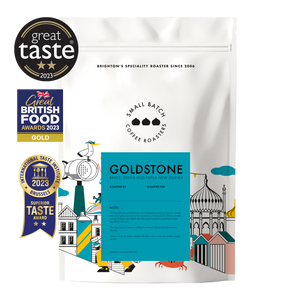Our Sustainability Report
Jan 16, 2025
At Small Batch Coffee Roasters, we are committed to reducing our carbon footprint and offering full transparency to our customers and community on how we achieve that throughout our business.
We’ve partnered with sustainability experts Zerobees, to measure our carbon footprint and develop a clear plan to reduce our emissions across our roastery and cafe. With their insight, we are already putting into action changes to reach our goal of 70% carbon reduction by 2030.
An overview…

Greenhouse gas (GHG) emissions are categorised into three scopes, but many businesses neglect to examine all three scopes, or use specific data and unverified methodologies to present more favourable data. At Small Batch Coffee Roasters, we are passionate that achieving carbon neutrality is imperative, and not just a marketing gimmick.
As part of our ongoing commitment to reducing our carbon emissions across the business, we have gathered industry specific data across all three scopes and we pledge to;
-
Never buy carbon offsets - we don’t believe planting a forest in another country will neutralise our carbon footprint here in Brighton.
-
Look to offer financial and educational support to our coffee farmers, to reduce our largest carbon emitters, the production and farming of green coffee.
-
Continue to audit our CO2 reduction, creating 100% transparent and traceable proof of our reduction efforts and results.
With these goals in mind we hope that Small Batch Coffee Roasters will become best in its class for traceable and verifiable sustainability.
In our Roastery…

Overall, based on 2023, our GHG emissions were estimated at ~789 tonnes CO2e - that’s equivalent to 478 return transatlantic flights or 455 average cars on the road for a year in the UK!
This data offered key insights for us, for example, we were certain the bulk of our emissions came from roasting, but in actual fact roastery operations only accounted for 7.9% of all our emissions. It’s actually the growing, harvesting & processing of green coffee that accounts for the majority of our footprint (53%). The most carbon intensive part of this phase is coffee production – the farming process, including the use of pesticides and fertilizer, attributed to 50.7%, whilst the decaffeination process (removing the caffeine from the coffee beans) had only a small impact on carbon emissions.
Another surprise to us was that brewing - just boiling the kettle & heating coffee machines in cafes - accounts for a further 26.7% of the roastery’s emissions, but is in line with other case studies we’ve researched into as being the second most impactful emitter. For example, coffees with more water e.g Americano will require more energy to make. As we expected, commercial coffee machines are likely to be considerably more energy intensive than home machines, depending on usage. Something for all of us to think about when buying a new machine, whether at home or at work, is looking at the energy efficiency of the machines, or looking at renewable energy tariffs to offset the usage and keep these emissions down.
Our packaging accounts for 4% of emissions, and this reflects work we have already done in this área, but we still believe there’s more that we can do. Whilst our boxes are made from 100% recycled materials, we plan to investigate using lighter boxes to reduce our cardboard use.
One final area of focus for us is going to be waste coffee. Our footprint showed that ‘disposal of coffee’ accounted for 5.3% of our emissions. This is based on what we know from our cafés and wholesale customers. Sending coffee grounds to landfill after use has an impact 79x higher than composting it (BEIS, 2023). This part is largely out of our control, but we hope by sharing our learnings and our commitment, we can encourage you and others to think about what you do with waste coffee.
In our cafes...

Looking at Goldstone Villas, we were pleasantly surprised that emissions in 2023 were 105.3 tonnes CO2e, equivalent to 64 return transatlantic flights or average cars on the road for a year in the UK. [1] Whilst it is still high, we were able to put it into perspective with some other case studies - our cafe carbon intensity was measured 2.7 tCO2e/£10k revenue, whilst in Costa’s baseline year, their intensity was ~4tCO2e/£10k revenue and Starbucks was ~8 tCO2e/10k revenue*. [2] It goes to show that most times, smaller is better when it comes to businesses!

Purchased goods and services represented 84% of emissions, but the split was slightly unexpected - the two most impactful goods purchased were milk (25%) and coffee (30%), and we were surprised just how high milk was.

So, let’s talk about milk - there have been many discussions about the impact of milk on the climate, and this data proves it: milk and non-dairy alternatives accounted for, on average, a combined impact of 31% across our two cafes. Unsurprisingly, per litre, cow’s milk generated more than three times the carbon emissions compared with alternatives [4], which makes up an average of 41% of total milk used in the cafes, again with oat milk being the most popular alternative, accounting for 31%. This is a huge amount of carbon relative to the business, so it is our intent to find new ways to reduce carbon created by dairy and create an innovative cafe experience.

Takeaway cups get a bad wrap, but only accounted for 4.1% of Small Batch’s emissions. On average, cups are 38% lower in emissions if they are recycled compared to if they are sent to landfill, and there are now many great initiatives to encourage closed loop sustainability, including charges for takeaway cups to encourage people bringing their own. From October 2025, all businesses with 10 or more full-time staff that sell takeaway drinks in fibre-based single-use cups will have to recycle them by law [5] and have a system in place that makes it easy for customers and staff to do so.
There was a huge variability with regards to the emissions associated with disposal of coffee (and food waste generally), with landfill after use waste having an impact 79x higher than composting (BEIS, 2023). Our waste emissions are 7 tCO2e, which, although are not high, can be significantly improved by working with our local community on disposal and renewability.
Our Carbon Reduction Plan…
We have reviewed our 2023 emissions data and created a five point plan to work towards our goal of 70% emissions reduction by 2030.
1. Work with our farmers to create insets. By providing them with training and financial support, we will then be able to buy these insets off of the farmers to help offset our carbon emissions.
2. Reduce our use of dairy milk by encouraging our customers to choose a dairy alternative for their milk of choice.
3. Inform our customers on the carbon emissions so they are able to make conscious decisions, whether at home or with us. Find innovative solutions to reuse our coffee waste, whilst working with the local community to close the loop.
4. Continue our commitment to purchasing transparently farmed, higher grade coffees in smaller quantities.
We will continue to remain 100% transparent as we work towards improving our sustainability journey, you can check out our social media for updates throughout the year, and please feel free to send us an email if you have any questions about our sustainability work!
[1] Ref: UK GOV 2022 – economy return trip from London to New York including radiative forcing emits 1.65 tCO2e Ref: DfT 2021 average car in the UK drives 7600 miles per year, releasing 1.735 tCO2
[2]*Ref: Starbucks (2018) Environmental Baseline Report, Costa (2019) Climate Roadmap
[3] *For more info see: https://drwakefield.com/swiss-water-decaf-process-coffee
[4] (Poore and Nemecek, 2018).
[5] https://www.biffa.co.uk/biffa-insights/biffa-launches-single-use-cup-recycling-scheme


